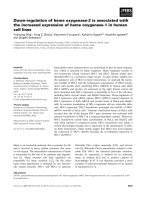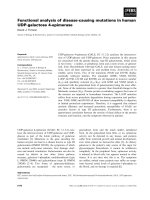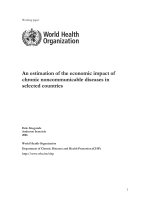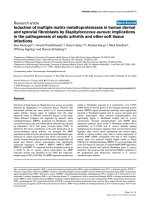The functional investigation of forkhead factor FOXQ1 in human breast and colon cancers
Bạn đang xem bản rút gọn của tài liệu. Xem và tải ngay bản đầy đủ của tài liệu tại đây (6.58 MB, 255 trang )
THE FUNCTIONAL INVESTIGATION OF FORKHEAD
FACTOR FOXQ1 IN HUMAN BREAST AND COLON
CANCERS
QIAO YUANYUAN
NATIONAL UNIVERSITY OF SINGAPORE
2011
THE FUNCTIONAL INVESTIGATION OF FORKHEAD
FACTOR FOXQ1 IN HUMAN BREAST AND COLON
CANCERS
QIAO YUANYUAN
MRes, Newcastle University, UK
A THESIS SUBMITTED FOR
THE DEGREE OF DOCTOR OF PHILOSOPHY
DEPARTMENT OF PHYSIOLOGY
NATIONAL UNIVERSITY OF SINGAPORE
2011
i
Acknowledgements
First of all I would like to take this opportunity to express my sincere thankfulness to
Dr. Yu Qiang, my supervisor, for his guidance and encouragement during these PhD
years. This is also a great opportunity to express my thankfulness to A/Prof. Hooi
Shing Chuan for being so supportive.
I would like to express my appreciation to National University of Singapore’s Yong
Loo Lin School of Medicine and Department of Physiology, especially to Department
Head A/Prof. Soong Tuck Wah for providing the scholarship to pursue my PhD
degree.
The Agency for Science, Research and Technology (A*STAR) has provided the right
environment which allowed me to do my research work at the Genome Institute of
Singapore (GIS).
I have made lasting friendship with my GIS colleagues at the laboratory of Cancer
Biology and Pharmacology. They are Mr. Tan Jing, Ms. Jiang Xia, Ms. Lee Sheut
Theng, Dr. Wu Zhenlong, Dr. Feng Min, Ms. Zhuang Li, Ms. Li Zhimei, Dr. Li
Jingsong, Dr. Yang Xiaojing, Ms. Lee Puey Leng, Ms. Aau Mei Yee, Ms. Cheryl Lim,
Mr. Eric Lee, Dr. Wong Chew Hooi and Mr. Adrian Wee.
And last but not least, my gratitude to my parents and fiancé for mentally supporting
me during these difficult and challenging years in Singapore.
ii
Table of Contents
Acknowledgements i
Table of Contents ii
Summary vii
List of Tables ix
List of Figures x
List of Abbreviations xiv
CHAPTER 1: INTRODUCTION 1
1.1 Overview of tumor 2
1.1.1 Structure of tumor 2
1.1.2 Tumor classification 3
1.1.3 Metastasis of cancer 4
1.2 Breast cancer 6
1.2.1 Epidemiology of breast cancer 6
1.2.2 Internal structure of mammary gland 6
1.2.3 Subtypes of breast cancer 9
1.2.4 Treatment of breast cancer 11
1.3 Colorectal cancer 13
1.3.1 Epidemiology of colorectal cancer 13
1.3.2 Molecular mechanism of colorectal cancer 14
1.3.2.1 Inactivation of tumor suppressor in colorectal cancer 14
1.3.2.2 Activation of oncogene pathway in colorectal cancer 16
1.4 Cancer stem cell 16
1.4.1 Models of tumor heterogeneity 17
1.4.2 Stem cell and cancer stem cell 21
1.4.3 CSCs in solid tumor 23
1.4.3.1 CSCs in breast tumor 24
iii
1.4.3.2 CSCs in brain tumor 26
1.4.3.3 CSCs in colorectal tumor 27
1.4.4 CSCs and biology of cancer metastases 28
1.4.5 Implication of CSCs for cancer therapy 29
1.5 Epithelial to mesenchymal transition 30
1.6 E-cadherin as a downstream effector in epithelial to mesenchymal transition 35
1.6.1 TGF-β signaling 35
1.6.2 The Snail family of gene repressors 38
1.6.3 Twist family 39
1.6.4 Zeb1 and Zeb2 41
1.6.5 Goosecoid 41
1.6.6 Other molecules promoting EMT 42
1.7 Forkhead box transcription factor family 43
1.7.1 FOXC1 and FOXC2 44
1.7.2 FOXM1 45
1.7.3 FOXF1 47
1.7.4 FOXO family 48
1.7.5 FOXA1 and FOXA2 49
1.7.6 FOXP1 and FOXP3 51
1.7.7 FOXG1 51
1.7.8 FOXQ1 52
1.8 Study objectives and rationale 55
CHAPTER 2: MATERIALS AND METHODS 56
2.1 Cell lines 57
2.2 Cell culture conditions 57
2.3 Cryogenic preservation 58
2.4 Drugs 59
2.5 Expression plasmid construction and molecular cloning procedure 59
2.6 Site-directed mutagenesis 67
2.7 Construction of RNAi-Ready pSIREN-RetroQ vector expressing FOXQ1
shRNA 68
2.7.1 shRNA oligonucleotide design 68
iv
2.7.2 Annealing the oligonucleotides 68
2.7.3 Ligation of double stranded oligonucleotide into RNAi-Ready pRIREN
vector 69
2.8 DNA agarose gel electrophoresis 71
2.9 DNA gel extraction 71
2.10 One Shot
®
TOP10 chemically competent E. coli transformation 71
2.11 Plasmid amplification and preparation 72
2.12 Sequences and plasmids for RNA interference 73
2.13 Transient transfection 73
2.14 Generation of stable cell lines 74
2.14.1 Tet-on inducible expression system 74
2.14.2 Retroviral expression system 75
2.14.3 Stable RNA interference system 76
2.15 Western blot analysis 77
2.16 Immunofluorescence confocal microscopy 78
2.17 Promoter construction 79
2.18 Luciferase reporter assay 81
2.19 Cell viability 81
2.20 Anchorage-independent growth by soft agar colony formation assay 82
2.21 Flow Cytometry/PI staining and active Caspase-3 activity through FACS
analysis 83
2.22 Invasion and migration assay 83
2.23 Three-dimensional matrigel culture 84
2.24 Mammosphere formation assay 85
2.25 Total RNA extraction 86
2.26 RT-PCR 87
2.27 Semi-quantitative RT-PCR 87
2.28 Microarray gene expression profiling 88
2.28.1 RNA amplification and labeling 88
2.28.2 Hybridization 89
2.28.3 Wash and imaging BeadChip 90
2.28.4 Gene expression profiling and Gene ontology analysis 91
2.29 Clinical relevance and survival analysis 91
v
2.30 Statistical analysis 92
CHAPTER 3: FUNCTIONAL CHARACTERIZATION OF FOXQ1 IN
BREAST CANCER 99
3.1 FOXQ1 expression is associated with aggressive breast cancer phenotypes 100
3.2 FOXQ1 depletion reduces mesenchymal phenotype and invasive ability of
MDA-MB-231 cells in vitro 105
3.3 Ectopic FOXQ1 expression in human mammary epithelial cells induces EMT
and mammosphere formation 114
3.4 Depletion of FOXQ1 expression in MDA-MB-231 cells increases sensitivity to
chemotherapy-induced apoptosis 125
3.5 FOXQ1 mediated transcription network in breast cancer cells 127
3.6 FOXQ1 represses E-cadherin transcription in breast cancer cells 130
3.7 Summary 135
CHAPTER 4: FUNCTIONAL CHARACTERIZATION OF FOXQ1 IN COLON
CANCER 140
4.1 FOXQ1 is overexpressed in colon cancer 141
4.2 Generation of Tet-on inducible FOXQ1 cell line system 145
4.3 Ectopic FOXQ1 expression induces epithelial to mesenchymal transition in
epithelial-like HCT116 colon cancer cells 150
4.4 Effect of FOXQ1 on proliferation rate in HCT116 cells 160
4.5 Identified transcriptional target of FOXQ1 that associated with epithelial to
mesenchymal transition 164
4.6 FOXQ1 induced EMT in HCT116 cells is independent of TGF-β signalling
pathway 168
4.7 Ectopic FOXQ1 expression in HCT116 cells confers resistance to apoptosis
induced by chemotherapeutic drugs 170
4.8 Summary 177
CHAPTER 5: CHARACTERIZATION OF FUNCTIONAL DOMAINS OF
FOXQ1 PROTEIN 178
5.1 Mapping the transactivation domain of FOXQ1 180
5.2 Validation of nuclear localization signal of FOXQ1 183
5.3 The N-terminal region of FOXQ1 contains an inhibitory domain 187
vi
5.4 Summary 191
CHAPTER 6: DISCUSSION 192
6.1 The potential of FOXQ1 in modulating epithelial plasticity 193
6.2 The transcriptional network mediated by FOXQ1 during EMT 198
6.2.1 CDH1 199
6.2.2 CTGF 200
6.2.3 Slug 203
6.3 FOXQ1-induced EMT in human mammary epithelial cells results in generation
of cancer stem cells 204
6.4 Chemoresistance mediated by high level of FOXQ1 in colon carcinomas 206
6.5 Repressed cell proliferation rate by ectopic FOXQ1 expression 209
6.6 Functional structures of FOXQ1 protein 211
6.7 Significance of this study 213
6.7.1 FOXQ1 is an important forkhead factor that regulates EMT 213
6.7.2 FOXQ1 may be used as a diagnostic and prognostic biomarker for
aggressive breast cancer and colon cancer 214
6.7.3 FOXQ1 may be used as potential therapeutic target for breast and colon
cancer 215
6.8 Conclusions 217
6.9 Future prospect 218
References 219
List of Publications 237
vii
Summary
The functional role of FOXQ1 in human cancers has recently and rapidly emerged a
year ago, which was almost a decade after it was first identified. In this study, I have
shown that FOXQ1 is closely associated with basal-like breast cancer subtype and
colorectal cancers. Its clinical relevance as provided by Oncomine database suggest
that FOXQ1 has potential therapeutic significance against breast cancer progression
and invasion.
In this study, the functional role of FOXQ1 was investigated in both breast and
colorectal cancers. During breast cancer progression, FOXQ1 was demonstrated to
participate in the aggressive behaviour of metastatic breast cancer cell line MDA-MB-
231. When ectopic FOXQ1 expression was introduced into immortalized human
mammary epithelial cell line (HMLER), this triggered a transformation from
epithelial morphology towards mesenchymal stage and the process is called
‘Epithelial to Mesenchymal Transition’ (EMT). FOXQ1 also generated breast cancer
stem cell-like population as defined by cells with surface antigen CD44+/CD24-
staining, and this enhanced the growth ability of mammospheres in vitro.
The induced EMT phenomenon by FOXQ1 was also observed in colorectal
carcinoma cell line HCT116 which has a typical epithelial morphology. Hence, the
resulting EMT by ectopic expression of FOXQ1 in HCT116 cells provided more
evidence that FOXQ1 may have a broader role to play in regulating epithelial
plasticity in human cancers. In HCT116 cells, FOXQ1 induced EMT also conferred
resistance to a series of chemotherapeutic drug-induced apoptosis. In view of the anti-
viii
apoptotic ability of FOXQ1 in colorectal cancer cells, I believe that FOXQ1 can be a
potential therapeutic target. In addition, depletion of FOXQ1 expression by RNAi in
aggressive breast cancer MDA-MB-231 cell line increased their sensitivity towards
several DNA-damaging drug-induced apoptosis by more than fifty percent in terms of
active Caspase 3 activity.
As a transcription factor, FOXQ1 regulates different targets in breast and colorectal
cancers. In breast cancer, no significance changes to known EMT regulators that
correlated with FOXQ1 were noticed in microarray gene expression analysis of
FOXQ1 ectopic expression or knockdown systems. As reporter assay demonstrated
that FOXQ1 was able to repress CDH1 promoter region of 450bp upstream and 193bp
downstream in vitro, I therefore propose that FOXQ1 directly regulated CDH1
transcriptional activity. In colorectal cancer, FOXQ1 has significantly increased two
well-known factors CTGF and Slug which were previously reported to regulate EMT.
What’s more, my reporter assay results showed that both CTGF and Slug promoters
were activated by FOXQ1, and CTGF promoter responded much more intensively to
FOXQ1 than Slug. Hence, CTGF promoter activity was used as an indicator in my
study of the functional domains of FOXQ1 protein. By constructing various FOXQ1
deletion mutants, I have further identified the transactivation domain, nuclear
localization signal (NLS) and inhibitory domain of FOXQ1 protein.
This thesis studied intensively the function of FOXQ1 in human cancer cells and
further identified its downstream transcriptional targets. The evidence presented in
this thesis showed that FOXQ1 is an important forkhead factor in cancer progression
and demonstrated that it is worth further exploring.
ix
List of Tables
Table 2.1 Genomic region of CTGF, SLUG, and CDH1 promoters 93
Table 2.2 Oligonucleotide primers for expression vector construction 94
Table 2.3 Oligonucleotide primers for RT-PCR 95
Table 2.4 Oligonucleotide primers for promoter construction 96
Table 2.5 Oligonucleotide for FOXQ1 shRNA construction 97
Table 2.6 Oligonucleotide primers for site-directed mutation vector construction 98
x
List of Figures
Figure 1.1 The metastatic cascade 5
Figure 1.2 Internal structure of mammary gland 8
Figure 1.3 Models of tumor heterogeneity 20
Figure 1.4 Epithelial to mesenchymal transition in cancer progression 34
Figure 2.1 Map of TA cloning vector pCR
®
2.1-TOPO
®
. 62
Figure 2.2 Map of mammalian expression vector pcDNA4/myc-His
®
. 63
Figure 2.3 Map of pcDNA6
TM
/TR vector of Tet-on inducible system. 64
Figure 2.4 Map of pcDNA4
TM
/TO/myc-His B expression vector in Tet-on inducible
system. 65
Figure 2.5 Schematic view of retroviral expression system ligated to FOXQ1 gene
with myc-tag. 66
Figure 2.6 Map of RNAi-Ready pSIREN-RetroQ vector. 70
Figure 2.7 Map of luciferase vector pGL3-Basic. 80
Figure 3.1 FOXQ1 is highly expressed in invasive breast cancer cells. 102
Figure 3.2 FOXQ1 expression is associated with aggressive breast cancers in clinical
databases. 104
Figure 3.3 Morphological change of MDA-MB-231 cells after depletion of FOXQ1
with various short hairpin RNA sequences and clones. 106
Figure 3.4 mRNA and protein levels of EMT markers and FOXQ1 in MDA-MB-231
FOXQ1 depleted cell lines. 108
Figure 3.5 Immunofluorescent confocal images of E-cadherin and vimentin in MDA-
MB-231 FOXQ1-SC depleted cells. 109
Figure 3.6 FOXQ1 depletion reduced the invasive ability of MDA-MB-231 cells in
vitro. 111
Figure 3.7 3D matrigel growth of MDA-MB-231 FOXQ1 depleted cells. 113
Figure 3.8 Ectopic expression of FOXQ1 in HMLER cells led to gain of
mesenchymal morphology and loss of epithelial phenotype. 115
Figure 3.9 Validation of ectopic FOXQ1 expression in HMLER cells. 116
Figure 3.10 Changes in the level of EMT markers which accompanied FOXQ1-
induced EMT in HMLER cells. 117
xi
Figure 3.11 Immunofluorescent confocal images of EMT markers in HMLER cells
expressing control vector or FOXQ1. 118
Figure 3.12 Breast cancer stem cell marker changes in HMLER cells expressing either
vector control or FOXQ1. 120
Figure 3.13 Ectopic expression of FOXQ1 in HMLER cells led to gain of stem cell-
like characteristics. 121
Figure 3.14 Morphology and mammosphere formation of E-cadherin knockdown
HMLER cells. 123
Figure 3.15 E-cadherin knockdown in HMLER cells induces EMT and stem cell-like
traits. 124
Figure 3.16 FOXQ1 depletion in MDA-MB-231 cells increases their drug sensitivity
in a dose-dependent manner. 126
Figure 3.17 Gene expression program associated with FOXQ1 expression. 129
Figure 3.18 Ingenuity Pathway Analysis (IPA) showing the top network of FOXQ1-
downregulated genes with CDH1 as a central node. 131
Figure 3.19 CDH1 promoter activity is negatively regulated by FOXQ1. 133
Figure 3.20 ChIP assay of FOXQ1 on the promoters of CDH1 in HMLER FOXQ1
overexpression cells. 134
Figure 3.21 Morphology of MCF10A and HMEC cells with ectopic expressing vector
pMN and FOXQ1. 138
Figure 3.22 Protein levels of EMT and breast cancer stem cell markers in MCF10A
and HMEC cells with ectopic expressing vector control pMN and FOXQ1.
139
Figure 4.1 FOXQ1 gene is highly expressed in 24 pairs of clinical colon tumor
samples. 142
Figure 4.2 FOXQ1 expression status in various human colon cancer cell lines. 144
Figure 4.3 Workflow of Tet-on inducible expression system. 146
Figure 4.4 Screening for functional Tet-on inducible FOXQ1 expression in six
HCT116 cell lines. 147
Figure 4.5 Confocal imaging of FOXQ1 expression in HCT116 Tet-on inducible cell
lines. 149
Figure 4.6 Morphologic change of HCT116-FOXQ1 cells. 152
Figure 4.7 Morphology of HCT116 cells expressing indicated FOXQ1 deletion. 153
xii
Figure 4.8 Long-term and steady FOXQ1 expression induced morphological change
in HCT116 associated with EMT. 156
Figure 4.9 Short-term FOXQ1 expression in HCT116 is not sufficient to trigger EMT
morphological change and there were no changes in EMT markers at both
mRNA and protein levels. 157
Figure 4.10 Immunofluroscent confocal images of EMT markers in HCT116-FOXQ1
cells with or without DOX and DOX withdrawn population. 159
Figure 4.11 Proliferation rate of HCT116 vector control cell lines in conditions of
with or without DOX (doxycycline) treatment. 161
Figure 4.12 Proliferation rate of full-length FOXQ1 expressing HCT116 cell lines in
conditions of with or without DOX (doxycycline) treatment. 162
Figure 4.13 Proliferation rate of D6 truncated FOXQ1 expressing HCT116 cell lines
in conditions of with or without DOX (doxycycline) treatment. 163
Figure 4.14 Identification of promoter region of CTGF in response to FOXQ1 in
HCT116. 165
Figure 4.15 Schematic structure of Slug promoter regions and luciferase reporter
activity of Slug promoter regions in response to FOXQ1. 167
Figure 4.16 RT-PCR images of Slug, CTGF and actin after HCT116 and HEK-TERV
cells treated with 10 ng/ml reconstituted TGF-β1 for indicated time points.
169
Figure 4.17 Phase contrast images of HCT116-FOXQ1 cells in response to stress
under conditions with or without DOX treatments. 171
Figure 4.18 Overexpression of FOXQ1 decreased apoptotic responses to 5FU
treatment (as measured by subG1 population) in HCT116 cells. 173
Figure 4.19 Ectopic expression of FOXQ1 in HCT116 cells confers resistance to
PARP cleavage induced by chemotherapeutic drugs. 175
Figure 4.20 FACS analysis of Caspase 3 activity of HCT116 FOXQ1 cells treated
with various drugs in the presence or absence of DOX. 176
Figure 5.1 Schematic structures of a series of deletion mutants of FOXQ1 protein. 179
Figure 5.2 Identification of transactivation domain of FOXQ1. 182
Figure 5.3 Localization of truncated FOXQ1 deletion mutants visualized by
immunofluroscent confocal microscopy. 184
Figure 5.4 Identification of nuclear localization signal of FOXQ1. 186
xiii
Figure 5.5 Identification of inhibitory domain of FOXQ1. 188
Figure 5.6 Potential phosphorylation sites of FOXQ1 190
xiv
List of Abbreviations
×g: times gravity
aa: amino acid
bp: base pair
BSA: bovine serum albumin
cDNA: complementary DNA
ChIP: chromatin immunoprecipitation
CSC: cancer stem cell
CTGF: connective tissue growth factor
DAPI: 4’, 6-diamidino-2-phenylindole
DBD: DNA binding domain
DDFS: Distant disease–free survival
DMEM: Dulbecco’s Modified Eagle’s Medium
DMSO: dimenthysulfoxide
DNA: deoxyribonuclease
DOX: doxycycline
E.coli: Escherichia coli
EDTA: ethylenediamine tetra-acetic acid
EGFR: Epidermal growth factor recerptor
EMT: epithelial to mesenchymal transition
ER: estrogen receptor
FBS: fetal bovine serum
G: gram
GAPDH: glyceraldehyde-3-phosphate dehydrogenase
xv
GFP: green fluorescence protein
HER2: human epidermal growth factor receptor 2
HR: hormone receptor
hr: hour
IHC: immunohostochemistry
LB: Lysogeny broth
LBX1: ladybird homeobox 1
MDCK: Madin-Darby canine kidney
mg: milligram
ml: millilitre
mM: mmilimolar
NaF: sodium fluoride
ng: nanogram
NLS: nuclear localization signal
nt: nucleotide
OS: overall survival
P: p-value
PAGE: polyacrylamide gel electrophoresis
PARP: poly(ADP-ribose) polymerase inhibitors
PARP: Poly(ADP-ribose)polymerase
PI: Protease Inhibitor
PMSF: phenylmethylsulfonyl fluoride
PR: progesterone receptor
PVDF: polyvinyllidene difluoride
xvi
qPCR: quantitative polymerase chain reaction
RNAi: RNA interference
rpm: revolutions per minute
RT-PCR: reverse-transcription polymerase chain reaction
SDS: sodium dodecyl sulphate
shRNA: short hairpin RNA
VEGF: vascular endothelial growth factor
1
CHAPTER 1:
INTRODUCTION
2
1.1 Overview of tumor
A tumor is a lesion resulting from autonomous or relatively autonomous abnormal
growth of cells which persisted even after the initiating stimulus had been removed.
Tumors can result from neoplastic transformation of any nucleated cell in the body,
although some cell types are more prone to tumor formation than others. The term
‘cancer’ means malignant tumor and it develops in approximately 25% of human
population with higher tendency in older people. The mortality rate associated with
cancer is high and is therefore of great clinical significance (Underwood 2004).
1.1.1 Structure of tumor
Solid tumors consist of neoplastic cells and stroma. The neoplastic cell population
reproduces to a variable extent depending on the growth pattern and synthesis activity
of the parent cell of origin. There is a functional resemblance to the parent tissue. The
neoplastic cell population is embedded in and supported by a connective tissue
framework called the stroma. It provides mechanical support and nutrition to the
neoplastic cells. Tumor stroma contains blood vessels which perfuse the tumor and
provide nutrition. The growth of a tumor is dependent upon its ability to induce blood
vessels to perfuse it, and this process is named angiogenesis. Histologically, a tumor
has the appearance of lost differentiation, weakened cellular cohesion, enlarged
nucleus and increased mitotic activity (Abell 1966; Smolak 1971; Folkman 1975).
3
1.1.2 Tumor classification
Tumors are classified according to their behavior and cell of origin. Depending on
behavior, they are classified into two groups, namely benign and malignant. Benign
tumors are relatively mild and remain localized within basement membrane. They are
slow growing lesions that do not invade the surrounding tissues or spread to distant
sites in the body. Malignant tumors on the other hand are rapidly growing and poorly
circumscribed. They bear less resemblance to parent cell or tissue compared to benign
tumor. Malignant tumor erodes into and destroys adjacent tissues, enabling neoplastic
cells to penetrate the walls of blood vessels and lymphatic channels, thereby
disseminating to distant sites. This important process is called metastasis and can
result in development of secondary tumors which are called metastases. However, not
all malignant tumors exhibit metastatic behavior. For example, basal cell carcinoma
of the skin rarely forms metastases, yet is regarded as malignant because it is highly
invasive and destructive (Zollinger 1968).
Tumors can arise from any part of the body. Depending on the cell of origin,
malignant tumors can be divided into several groups. Malignant tumors arising from
the epithelium are called carcinoma; from the mesenchyme or connective tissue are
called sarcoma; teratoma has a mix of origin. Carcinoma is the most popular
malignant tumor. Here, I will only focus on carcinomas, which arise in epithelial
tissues. Normally, cells that form the epithelial sheets in tissues are tightly bound to
neighboring cells as well as to the underlying basement membrane by adherens
junctions which are tight junctions that effectively immobilize them in these sheets.
These tight physical constraints are not only limited to normal epithelial cells, but also
4
those within many benign carcinomas. However, when a tumor progresses, the
carcinoma cells liberate themselves from these associations and begin to migrate out
on their own, first by dissolving underlying basement membranes and then invading
adjacent stromal compartments. This invasiveness seems to empower carcinoma cells
to both intravasate and subsequently extravasate (Thiery and Sleeman 2006).
1.1.3 Metastasis of cancer
Metastasis is responsible for as much as 90% of the great cancer-associated mortality.
Yet, it remains the most poorly understood component of cancer pathogenesis. During
metastatic dissemination, a cancer cell from a primary tumor executes a sequence of
steps. First of all, it locally invades the surrounding tissue. Secondly, it enters the
microvasculature of the lymph and blood systems (intravasation). Thirdly, it survives
and translocates largely through the bloodstream to microvessels of distant tissues,
then exits from the bloodstream (extravasation), survives in the microenvironment of
distant tissues, and finally adapts to the foreign microenvironment of these tissues in
ways that facilitate cell proliferation and the formation of a macroscopic secondary
tumor (colonization) (Fidler 2003). This complex metastatic cascade can be
conceptually broken down into two major phases: (i) physical translocation of a
cancer cell from the primary tumor to the microenvironment of a distant tissue and
then (ii) colonization (Figure 1.1). Presently, our knowledge of physical dissemination
is becoming clearer, whereas the second phase, colonization, involves complicated
interactions that may still require many years of research before we fully understand
the mechanism. From the standpoint of treatment, knowing the mechanisms of
physical translocation is likely to be important for preventing metastasis in patients
5
who are diagnosed with early tumor, whereas understanding the mechanisms leading
to successful colonization may lead to effective therapies for patients with existing
metastases (Chaffer and Weinberg 2011).
Figure 1.1 The metastatic cascade
Metastasis can be envisioned as a process that occurs in two major phases: (i) physical
translocation of cancer cells from the primary tumor to a distant organ and (ii)
colonization of the translocated cells within that organ. (A) To begin the metastatic
cascade, cancer cells within the primary tumor acquire an invasive phenotype. (B)
Cancer cells can then invade into the surrounding matrix and toward blood vessels,
where they intravasate to enter the circulation, which serves as their primary means of
passage to distant organs. (C) Cancer cells traveling through the circulation are
circulating tumor cells (CTCs). They display properties of anchorage-independent
survival. (D) At the distant organ, CTCs exit the circulation and invade into the
microenvironment of the foreign tissue. (E) At that foreign site, cancer cells must be
able to evade the innate immune response and also survive as a single cell (or as a
small cluster of cells). (F) To develop into an active macrometastatic deposit, the
cancer cell must be able to adapt to the microenvironment and initiate proliferation
(Chaffer and Weinberg 2011).
6
1.2 Breast cancer
1.2.1 Epidemiology of breast cancer
Breast cancer is currently the most leading cancer among women with an estimated
1.38 million new cancer cases diagnosed in 2008 (23% of all cancers), and ranks
second overall (10.9% of all cancers). It is now the most common cancer in both
developed and developing regions with an estimated 690,000 new cases in each
region. Incidence rates vary from 19.3 per 100,000 women in Eastern Africa to 89.7
per 100,000 women in Western Europe, and are high (greater than 80 per 100,000) in
developed regions of the world (except Japan) but low (less than 40 per 100,000) in
most of the developing regions. The range of mortality rates is however lower
(approximately 6-19 per 100,000) because of the more favorable survival of breast
cancer in (high-incidence) developed regions. As a result, breast cancer ranks as the
fifth cause of death from cancer overall (458,000 deaths), but it is still the most
frequent cause of cancer death in women in both developing (269,000 deaths, 12.7%
of total) and developed regions, where the estimated 189,000 deaths is nearly equal to
the estimated number of deaths from lung cancer (188,000 deaths) (Ferlay J, Shin HR
et al. 2010).
1.2.2 Internal structure of mammary gland
Each mammary gland has 15-20 lobes arranged in a circular fashion, each of which
has many smaller lobules. At the end of the lobules are tiny bulb-like glands, or sacs,
where milk is produced. The lobes, lobules and glands are connected by thin ducts.
These ducts channel milk to openings in the nipple. The lobules are secretory units of
7
breast, each lobule consists of a certain number of acini, or glands, embedded within
loose connective tissue and connecting to the intralobule duct. Each acinus is
composed of two types of cells, namely epithelial and myoepithelial cells. The
epithelial cells form glandular lumens surrounded by myoepithelial cells which rest
on the basement membrane (Figure 1.2). The most frequent type of breast cancer
starts in the duct (ductal cancer), while other types begin in the lobes or lobules
(lobular carcinoma). Less common is the inflammatory breast cancer where the breast
becomes red and swollen (Debnath, Muthuswamy et al. 2003).









